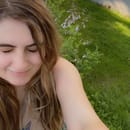Have you ever read a poem, or even the lyrics of a song, so potent that you could do nothing but sit there, stare at the wall, and contemplate your entire life for five minutes until an inevitable and perhaps relieving distraction pulled you back to your surroundings? Dramatic, I know, but a feeling like no other. As a lesbian English and Environmental Studies double major, perhaps this is no shock, but I have a deep fascination with and love for poems intersecting queerness and the environment. My experience with either topic is obviously limited to my own life and not encompassing of all experiences by any means, but I believe there is so much to be seen and felt through queer ecopoetry– queer justice cannot properly exist without environmental justice, and vice versa. The ways nature has called to and pulled in queer poets make it very hard to separate the two. They are, if not intrinsically linked, intertwined now so tightly together that not even a master of discernment could come even close to breaking them apart. Drawing from my lived experiences as a lesbian, I will be focusing primarily on lesbian and sapphic poems and themes in this article. However, that does not mean there is not endless possibility and merit in the analysis of gay, bisexual, trans, or other poetry that encompasses nature.
We do, of course, have our modern ecopoets and poems, of whom there are blissfully many. Writers like Alicia Mountain compose poignant and hard-hitting works which combine almost seamlessly the ways of the natural world and the experience of being a woman in love with another woman. The way Mountain’s compositions simultaneously lean on nature and weave it into the queer experience to strengthen, rather than simply support, the messages they aim to get across is unmistakable and fascinating. There is often very little “hiding” to be done in these modern works, even if metaphors and interconnecting webs are formed into the natural world.
Such a lack of “hiding” would never have happened if not for the queer and trans activists that paved the way for it– both through direct and outward protest pioneered by Marsha P. Johnson and Sylvia Rivera (among others), and through quieter and more indirect forms done by many a queer writer or artist. While the most famous examples– think Emily Dickinson and Sylvia Plath– were certainly of great influence, so too were lesser known or more silenced poets such as Adrienne Rich and the Chinese poet Wu Tsao. While so many of their works at least started out less directly, they ultimately are why I can write this article in the first place. I would never have even known I was a lesbian if not for poetry, and probably would be sitting here incredibly confused and frustrated as to why I do not feel the same way about any man as one might expect. These individuals have allowed queerness to be an outward element in poetry, as natural to it as the throes of any heterosexual love, allowing it to simply be– to exist without having to prove some merit or be hidden away under false disguise. They have utilized it as an outward quality, but also enabled it to serve as a layer like any other, as opposed to the one and only glaring point of the poem or work purely because it exists there.
I think of the layers of queer poems and songs– how many of them exist in so many different realms and resonate with so many different experiences. I think of the discography, and especially the album Preacher’s Daughter, of singer-songwriter Ethel Cain. While the titular character of the work’s sexuality and gender identity are undefined (and do not need to be defined), there are layers and areas of resonation with almost everyone who listens to it. I have personally gotten so much out of that work on so many different levels– experiencing misogyny and sexual assault, wanting simply to be loved and accepted, and running away from the past so hard that you wind up in a worse situation– but I also know that there are so many I will never truly grasp. I grew up queer in New England, for example, with a much smaller chance of being shunned for it than Ethel experienced in both her real and fictional life in the Southern United States. For this reason, I cannot relate to it in the same ways it resonates with trans women, as the singer herself is.
Nature has been an escape, a place without judgment, and a place of deep discontent for queer women– sometimes all at once. When you are told that your love and identity are not “natural,” but the natural world is the only one that seems to accept you with open arms, what do you do? Are you challenging nature by suppressing your sexuality? Or are you, as so often said, defying it by loving and existing as you are? Is it any wonder the rivers and trees and animals are especially present in this type of poetry? Is it any shock that they are often so much more intertwined than other contemporary ecopoems? What is nature, anyway? And who gets to decide?


